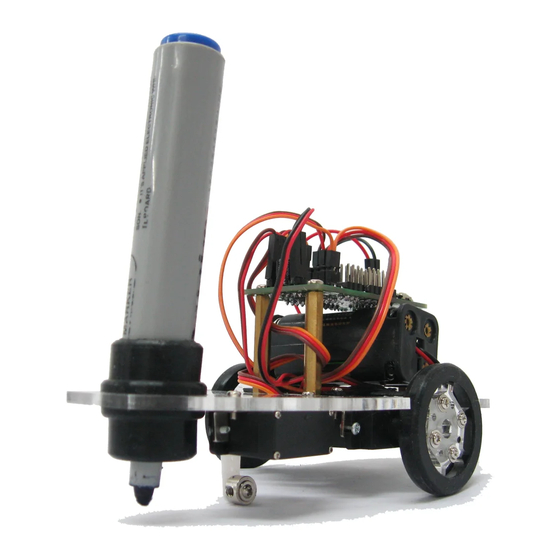DAGU RS025 Руководство - Страница 12
Просмотреть онлайн или скачать pdf Руководство для Робототехника DAGU RS025. DAGU RS025 12 страниц.

Troubleshooting continued:
Problem: One of the motors does not turn.
Solution: Check that the jumpers are placed correctly on D7, D8, D9 and D10.
Problem: When the program runs, the robot goes forward slightly and then goes in circles.
Solution: Make sure your encoders are plugged into the correct sockets as shown (Wiring Instructions).
Problem: The pen does not raise or lower. The servo just sits in one position.
Solution: Check that the servo is connected to D12. Make sure the signal wire (orange or white) is closest to the
processor as shown in the wiring instructions. Check that V+ selection jumper is set to +5V.
Problem: The USB port is not recognised by your computer or does not show up in the Arduino IDE.
Solution: Make sure you do not have anything connected to the serial communications socket while using the
USB cable. Make sure you have the latest CP2102 USB interface drivers installed (Installing the Software).
Using the controller as an Arduino board:
The DAGU mini driver is software compatible with
an Arduino NG. It has been designed specifically
for robotics so it has a few extra features.
Up to 8 servos can be connected directly to the
PCB by changing the +V selector from 5V to Bat.
This allows the servos to be powered directly from
the battery as the 5V regulator is only capable of
powering 1 miniature servo under a light load.
Analog pins A0-A5 have 5V and Gnd pins available
for powering 5V sensors. As the SMD chip has
extra pins there are 2 exta analog inputs. A6 is not
used although it can be accessed by a solder pad
under the PCB. A7 is configured to monitor battery
voltage. The maximum allowable battery voltage is
9V.
The dual "H" bridge is capable of driving 2 motors,
each with a stall current of 2A or 1 stepper motor
with a maximum of 2A per winding.
If you do not wish to use the motor driver then you
can remove the jumpers on D7, D8, D9 and D10.
You can then use these pins for alternate purposes.
There is a 4 pin female header on the PCB that is
intended for use with a wireless transceiver such as
an Xbee or Bluetooth module. You can access D0
and D1 (Rx and Tx) directly from this header.
The ISP socket is the same as a standard Arduino
board and can be used to re-burn the bootloader.
Newer versions of the Arduino IDE will allow you to
program the board directly from this socket. Note
that there is a small white arrowhead next to pin 1.
Specifications:
Controller:
Processor:
Clock speed:
FLASH:
SRAM:
EEPROM:
USB interface:
Supply voltage:
Regulator:
Dual "H" bridge:
Battery +
Battery -
Switch
+V: Bat/5V
ATmega8A
16MHz
8K
1K
512 bytes
CP2102
5V - 9V
1A max.
2A per motor
Power
D2
D3
D4
D5
D6
D11
D12
D13
Gnd 5V
5V
S
S
D9 D7 D10 D8
D9 D7 D10 D8
Left
motor
Output devices:
Servo voltage:
Servo torque:
Servo speed:
Servo weight:
Motor voltage:
Gearbox torque:
Speed:
Weight:
USB
5V G
G T
S
S
5V
5V
Gnd
T
R
R
X
X
X
X
ATmega
ATmega
8A
8A
Right
motor
4V - 6V
2Kg/cm
6V
0.08 sec/60°
6V
12g
6V
2Kg/cm max.
125RPM ±10%
6V
9g
Reset
A5
A4
A3
A2
A1
A0
D13
LED
